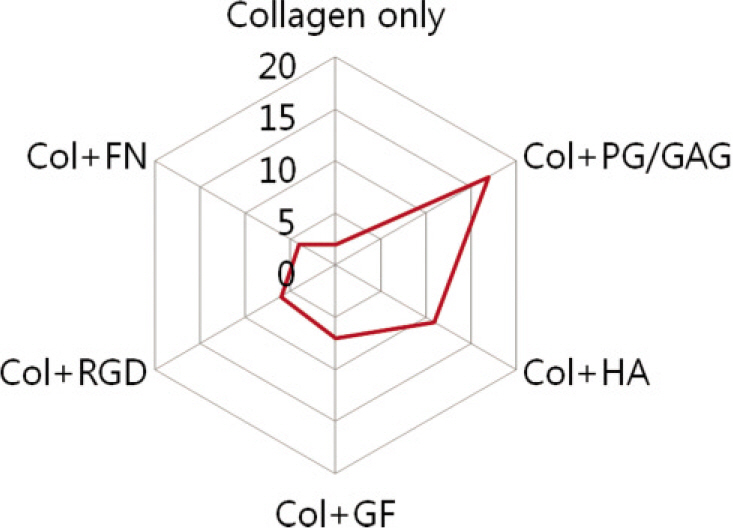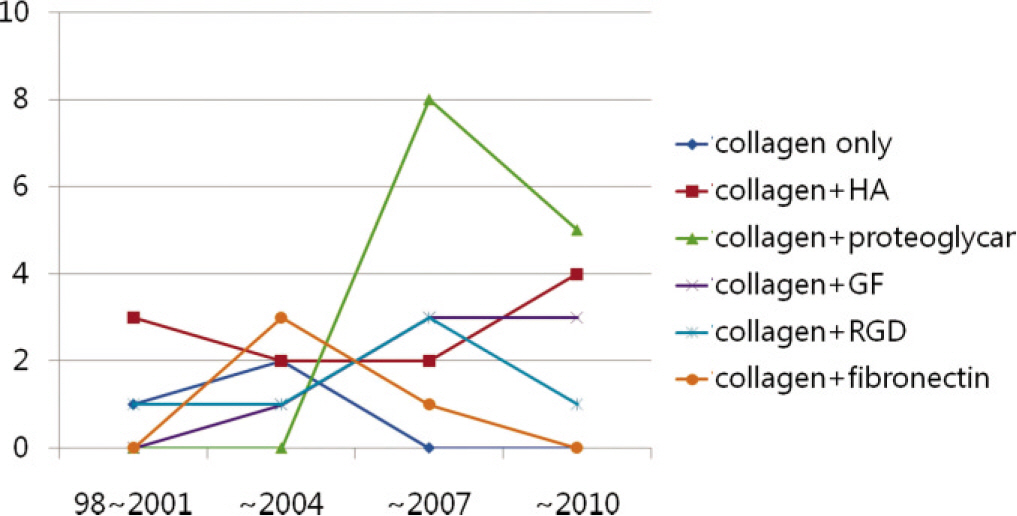J Korean Acad Prosthodont.
2011 Jul;49(3):254-262.
Review of the developmental trend of implant surface modification using organic biomaterials
- Affiliations
-
- 1Department of Prosthodontics, Department of Dentistry, Korea University Ansan Hospital, Ansan, Korea. koprosth@unitel.co.kr
- 2Cellbiocontrol Laboratory, Department of Medical Engineering, Yonsei University College of Medicine, Institute for Dental Research, Korea University, Korea University Guro Hospital, Seoul, Korea.
- 3Department of Prosthodontics, School of Dentistry, Pusan National University, Yangsan, Korea.
- 4Department of Prosthodontics, Department of Dentistry, Seoul Veterans Hospital, Seoul, Korea.
Abstract
- PURPOSE
This study aims to evaluate and prospect for current research trend and developmental perspectives via analyzing recent biomaterial coated-implants study.
MATERIALS AND METHODS
To investigate each subject respectively, several biomaterials that are using for implant surface coating were set as 'keywords'. By these keywords, major research groups in each subject were chosen, and research trend of them was analyzed. Trend of In vivo studies that examined selected biomaterials were analyzed to evaluate commercial potential.
RESULTS
The collagen research accounted for 40% of total implant study, which was the highest, and fibronectin, BMPs (bone morphogenetic proteins) and RGD (Arg-Gly-Asp) peptides followed, which were ranked in descending order. Furthermore, figures of all four research subjects were also increased with time, especially a sharp increase in RGD research. According to the results of major research group, collagen that was combined with other organic and inorganic biomaterials was mostly examined, rather than using collagen only. Major research groups investigating BMPs mostly focused on rhBMP-2. In animal studies, collagen was used as resorbable membrane in guided bone regeneration (GBR) or drug carrier, while BMPs were used with bone graft materials or coating material for titanium implant surface.
CONCLUSION
There is not consistency of results even in identical subjects research field. Many studies are ongoing to optimize combination between mechanical surface treatment and biomaterials such as extracellular matrix component and growth factors.
MeSH Terms
-
Animals
Biocompatible Materials
Bone Regeneration
Collagen
Dental Implants
Drug Carriers
Extracellular Matrix
Fibronectins
Humans
Intercellular Signaling Peptides and Proteins
Membranes
Peptides
Research Subjects
Titanium
Transplants
Biocompatible Materials
Collagen
Dental Implants
Drug Carriers
Fibronectins
Intercellular Signaling Peptides and Proteins
Peptides
Titanium
Figure
Reference
-
1.Bra�nemark PI., Adell R., Breine U., Hansson BO., Lindstro ¨m J., Ohlsson A. Intra-osseous anchorage of dental prostheses. I. Experimental studies. Scand J Plast Reconstr Surg. 1969. 3:81–100.2.Bra�nemark PI., Hansson BO., Adell R., Breine U., Lindstro ¨m J., Halle′n O., Ohman A. Osseointegrated implants in the treatment of the edentulous jaw. Experience from a 10-year period. Scand J Plast Reconstr Surg Suppl. 1977. 16:1–132.3.Schroeder A., Pohler O., Sutter F. Tissue reaction to an implant of a titanium hollow cylinder with a titanium surface spray layer. SSO Schweiz Monatsschr Zahnheilkd. 1976. 86:713–27.4.Ostman PO. Immediate/early loading of dental implants. Clinical documentation and presentation of a treatment concept. Periodontol 2000. 2008. 47:90–112.
Article5.Binon PP. Implants and components: entering the new millennium. Int J Oral Maxillofac Implants. 2000. 15:76–94.6.Esposito M., Murray-Curtis L., Grusovin MG., Coulthard P., Worthington HV. Interventions for replacing missing teeth: different types of dental implants. Cochrane Database of Systematic Reviews. 2007. 4:Art. No.: CD003815.
Article7.Kasemo B., Gold J. Implant surfaces and interface processes. Adv Dent Res. 1999. 13:8–20.
Article8.Chang PC., Lang NP., Giannobile WV. Evaluation of functional dynamics during osseointegration and regeneration associated with oral implants. Clin Oral Implants Res. 2010. 21:1–12.
Article9.Junker R., Dimakis A., Thoneick M., Jansen JA. Effects of implant surface coatings and composition on bone integration: a systematic review. Clin Oral Implants Res. 2009. 20:185–206.
Article10.Coelho PG., Granjeiro JM., Romanos GE., Suzuki M., Silva NR., Cardaropoli G., Thompson VP., Lemons JE. Basic research methods and current trends of dental implant surfaces. J Biomed Mater Res B Appl Biomater. 2009. 88:579–96.
Article11.Kim TI., Jang JH., Kim HW., Knowles JC., Ku Y. Biomimetic approach to dental implants. Curr Pharm Des. 2008. 14:2201–11.
Article12.Zhang Y., Shi B., Li C., Wang Y., Chen Y., Zhang W., Luo T., Cheng X. The synergetic bone-forming effects of combinations of growth factors expressed by adenovirus vectors on chitosan/collagen scaffolds. J Control Release. 2009. 136:172–8.
Article13.Leknes KN., Yang J., Qahash M., Polimeni G., Susin C., Wikesjo ¨ UM. Alveolar ridge augmentation using implants coated with recombinant human bone morphogenetic protein-7 (rhBMP-7/rhOP-1): radiographic observations. J Clin Periodontol. 2008. 35:914–9.
Article14.Leknes KN., Yang J., Qahash M., Polimeni G., Susin C., Wikesjo ¨ UM. Alveolar ridge augmentation using implants coated with recombinant human bone morphogenetic protein-2: radiographic observations. Clin Oral Implants Res. 2008. 19:1027–33.
Article15.Baas J., Elmengaard B., Jensen TB., Jakobsen T., Andersen NT., Soballe K. The effect of pretreating morselized allograft bone with rhBMP-2 and/or pamidronate on the fixation of porous Ti and HA-coated implants. Biomaterials. 2008. 29:2915–22.
Article16.Salata LA., Burgos PM., Rasmusson L., Novaes AB., Papalexiou V., Dahlin C., Sennerby L. Osseointegration of oxidized and turned implants in circumferential bone defects with and without adjunctive therapies: an experimental study on BMP-2 and autogenous bone graft in the dog mandible. Int J Oral Maxillofac Surg. 2007. 36:62–71.
Article
- Full Text Links
- Actions
-
Cited
- CITED
-
- Close
- Share
- Similar articles
-
- A comprehensive review of techniques for biofunctionalization of titanium
- The effects of local factors on the survival of dental implants: A 19 year retrospective study
- Antimicrobial surfaces for craniofacial implants: state of the art
- Current trends in dental implants
- 3D printing technology for periodontal complex neogenesis in regenerative medicine










